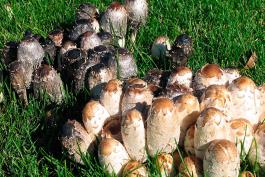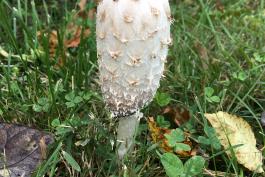
White, shaggy, cylindrical cap that turns black and inky. Often grows in large numbers along roadsides and in lawns and disturbed areas. September–October. Cap cylindrical, long, gradually expanding to bell-shaped; white, with flat white scales turning brownish; texture shaggy; with age, cap and gills become inky and liquefy. Gills narrow; spacing very crowded; white, becoming black and inky from the margin inward; attachment free. Stalk tall, straight, slightly bulbous at base; white; texture smooth. Spore print black. Spores magnified are elliptical, smooth, with small pore at tip.
Lookalikes: The green-spored lepiota (Chlorophyllum molybdites) has green spores and its cap is less cylindrical.
Cap width: 1–2½ inches; cap height 1½–6 inches; stalk length: 1½–8 inches; stalk width: ¼–¾ inch.

Statewide.
Habitat and Conservation
Often grows in large numbers along roadsides and in lawns and disturbed areas. Though the shaggy mane is somewhat fragile, it can pop up in strange places—like wood chip piles, hard ground, roadsides, and even asphalt parking lots. It can reappear in the same area for a few years.
Status
Considered a choice edible, but you have to move fast! Shaggy manes have a very short "shelf-life," typically only lasting 24 hours from emerging to liquefying. Pick only young, fresh specimens. If you want to store them, cook them as soon as you can after harvesting, then refrigerate. Once picked, they will dissolve into inky liquid in just a few hours.
Life Cycle
This species exists most of the time in the soil as a network of cells (mycelium), taking nourishment from rotting wood and other decaying materials. When ready to reproduce, the mycelium develops mushrooms, which are reproductive structures that produce spores. The spores are released to begin new mycelia elsewhere. In inky caps, the spores are dispersed when the cap decays and liquefies.
Human Connections
Mushrooms decorate nature the way wildflowers do, adding to our pleasure on hikes. Like wildflowers, they are often bestowed with poetic or fanciful names, reflecting the amusement they bring to us. This species is also called "lawyer's wig" for its resemblance to barristers' wigs worn in Britain.
Ecosystem Connections
This is one of the many fungus species that live on decaying materials in the soil. It and other such saprobic fungi play an incredibly important role in recycling organic molecules and returning those nutrients to the soil.




Mushrooms are a lot like plants, but they lack chlorophyll and have to take nutrients from other materials. Mushrooms are neither plants nor animals. They are in a different kingdom — the fungi. Fungi include the familiar mushroom-forming species, plus the yeasts, molds, smuts, and rusts.
Always be cautious when eating edible mushrooms. Be absolutely sure of the ID, and only eat a small amount the first time you try it to avoid a reaction..





















